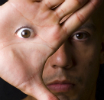
Session Overview
 |
How do we identify things in our environment? How are we able to perceive objects like faces? During this lecture, we will explore how we are able to recognize objects and how the visual system interacts with our brain to make sense of what we see. Keywords: agnosia, prognosia, perception, amygdale, facial recognition |
Session Activities
Readings
Read the following before watching the lecture video.
- One of the following textbook chapters:
Lecture Videos
View Full Video
- Lecture 6: Vision II (00:56:20)
View by Chapter
- Introduction to Recognition (00:01:48)
- Problems With Object Recognition (00:12:47)
- Recognizing Faces and Prosopagnosia (00:06:27)
- The Development of Facial Recognition (00:11:08)
The Development of Facial Recognition
> Download from iTunes U (MP4 - 121MB)
> Download from Internet Archive (MP4 - 121MB)
- Word Recognition and Alexia (00:05:33)
- Predisposition to Facial Recognition (00:06:46)
Predisposition to Facial Recognition
> Download from iTunes U (MP4 - 121MB)
> Download from Internet Archive (MP4 - 121MB)
- Race and Facial Recognition (00:05:54)
- Recognizing Fear (00:03:53)
Video Resources
Discussion: Vision
We'll talk about sensation – how light, the physical stimulus in the world, is transduced by your eye and becomes neural signals… Read more »
Further Study
Writing Assignment 1: Are studies of cognitive and emotional developments in adolescents useful for setting public policy guidelines?
These optional resources are provided for students that wish to explore this topic more fully.
| TYPE | CONTENT | CONTEXT |
|---|---|---|
| Podcast | "Strangers in the Mirror" on Radiolab. Hosted by Robert Krulwich, with guests Oliver Sacks and Chuck Close. Uploaded Tuesday, June 15, 2010. | An interview Oliver Sacks, a neuroscientist, and Chuck Close, an artist, both of whom have face blindness. |
| Website | TarrLab | A Carnegie Mellon University lab headed by Mike Tarr that focuses on visual perception and how humans process, recognize, and remember objects and faces. |
| Textbook supplement | Study materials for Chapter 3, "Psychology Sensation and Perception: How the World Enters the Mind," in Study Site for Psychology in Context, 3/e (Pearson Education, 2007) | Practice test questions, flashcards, and media for a related textbook by Kosslyn & Rosenberg |
